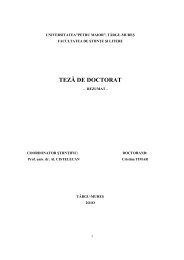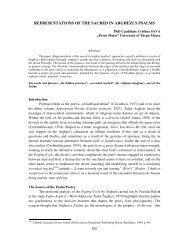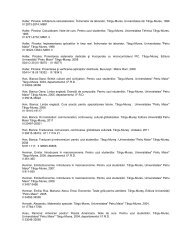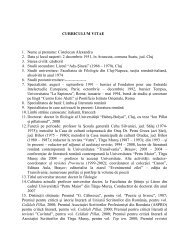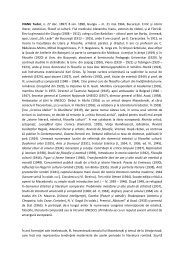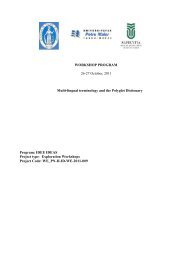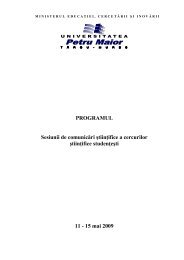The concept of self in virginia woolf's mrs - Universitatea"Petru Maior"
The concept of self in virginia woolf's mrs - Universitatea"Petru Maior"
The concept of self in virginia woolf's mrs - Universitatea"Petru Maior"
You also want an ePaper? Increase the reach of your titles
YUMPU automatically turns print PDFs into web optimized ePapers that Google loves.
THE CONCEPT OF SELF<br />
IN VIRGINIA WOOLF’S MRS. DALLOWAY<br />
Abstract<br />
689<br />
Asistent univ. Crist<strong>in</strong>a NICOLAE<br />
Universitatea „<strong>Petru</strong> Maior”, Târgu-Mureş<br />
Meditat<strong>in</strong>g on the <strong>self</strong> represented a permanent challenge and need to Virg<strong>in</strong>ia Woolf <strong>in</strong> both life and<br />
art. Analysed from this perspective, the characters that animate the world she imag<strong>in</strong>es/remembers are to be<br />
seen as reflections/representations <strong>of</strong> her own search for <strong>self</strong>hood, a quest for <strong>self</strong>-understand<strong>in</strong>g <strong>in</strong> fact, for it is<br />
through writ<strong>in</strong>g that Woolf frees her<strong>self</strong> and keeps a sense <strong>of</strong> proportions <strong>in</strong> draw<strong>in</strong>g the boundary between<br />
real and unreal, sanity and <strong>in</strong>sanity, life and death.<br />
Motto: “Every man’s work, whether it be literature or music or pictures<br />
or architecture or anyth<strong>in</strong>g else, is always a portrait <strong>of</strong> him<strong>self</strong>.”<br />
(Samuel Butler)<br />
Life and Virg<strong>in</strong>ia Woolf co-create a space, Caramagno (qtd. <strong>in</strong> Fand: 77-78) asserts, <strong>in</strong><br />
which the <strong>self</strong> (with its subjectivities, the <strong>in</strong>ner world) and the world beyond the <strong>self</strong> (the<br />
outer, objective world) can exist and where, <strong>in</strong> fact, they must meet. It is this space <strong>of</strong> the<br />
written discourse that the present paper approaches, with a focus on the parallel and<br />
contrastive analysis <strong>of</strong> the major characters <strong>in</strong> Mrs Dalloway.<br />
<strong>The</strong> very act <strong>of</strong> writ<strong>in</strong>g represents at times an attempt to escape the real world, or at<br />
other times a sort <strong>of</strong> com<strong>in</strong>g to terms with her<strong>self</strong>, with her past, memories, long<strong>in</strong>gs, fears.<br />
Thus, to Woolf writ<strong>in</strong>g became a therapy, a means <strong>of</strong> explor<strong>in</strong>g the existential labyr<strong>in</strong>th, a<br />
way <strong>of</strong> f<strong>in</strong>d<strong>in</strong>g some equilibrium between sw<strong>in</strong>gs <strong>of</strong> mood, an exploration <strong>of</strong> her <strong>in</strong>ner states<br />
<strong>in</strong> the hope <strong>of</strong> f<strong>in</strong>d<strong>in</strong>g a way out <strong>of</strong> this labyr<strong>in</strong>th (Fand: 44). “It is this writ<strong>in</strong>g that gives me<br />
my proportions”, writes Woolf <strong>in</strong> her diary, po<strong>in</strong>t<strong>in</strong>g out the fact that the written word is her<br />
own way <strong>of</strong> defeat<strong>in</strong>g madness which she def<strong>in</strong>es (through the perspective <strong>of</strong> Sir William<br />
Bradshaw, one <strong>of</strong> Woolf’s voices <strong>in</strong> Mrs Dalloway) as “not hav<strong>in</strong>g a sense <strong>of</strong> proportions”<br />
(MD, 107).<br />
Her discourses are to be seen as a way <strong>of</strong> represent<strong>in</strong>g her<strong>self</strong> to her<strong>self</strong> and to her<br />
public as well (Fand, 47). Present <strong>in</strong> her works as a literary strategy and value, the <strong>self</strong> is at<br />
the heart <strong>of</strong> Virg<strong>in</strong>ia Woolf’s exploration <strong>of</strong> the characters’ and her own patterns <strong>of</strong> thought,<br />
we, the readers, be<strong>in</strong>g <strong>of</strong>fered a glimpse at the <strong>in</strong>terior labyr<strong>in</strong>th. <strong>The</strong> novel becomes a way <strong>of</strong><br />
re-th<strong>in</strong>k<strong>in</strong>g life, <strong>of</strong> experiment<strong>in</strong>g, <strong>of</strong> explor<strong>in</strong>g time, space, memory and consciousness, the<br />
very <strong>concept</strong> <strong>of</strong> <strong>self</strong> (private and public), with an impact on the creation <strong>of</strong> identity.
Roxanne Fand states <strong>in</strong> her 1999 book, <strong>The</strong> Dialogic Self: Reconstruct<strong>in</strong>g Subjectivity<br />
<strong>in</strong> Woolf, Less<strong>in</strong>g, and Atwood, that Woolf’s <strong>concept</strong> <strong>of</strong> <strong>self</strong> (<strong>in</strong> both life and work, we might<br />
add) is “dialogic”, and expla<strong>in</strong>s her statement by mak<strong>in</strong>g use <strong>of</strong> words such as “game”,<br />
“shift<strong>in</strong>g centers <strong>of</strong> <strong>in</strong>teraction”, “boundaries that appear and diappear”, all underl<strong>in</strong><strong>in</strong>g<br />
Woolf’s ability to play with the boundaries <strong>of</strong> the <strong>self</strong>, a “dialogic impulse” that br<strong>in</strong>gs<br />
together the fem<strong>in</strong><strong>in</strong>e and the mascul<strong>in</strong>e and deconstructs the terms <strong>of</strong> gender by “the<br />
convolution <strong>of</strong> discourses <strong>in</strong> her characters’ m<strong>in</strong>ds” (43-44):<br />
Virg<strong>in</strong>ia Woolf’s <strong>concept</strong> <strong>of</strong> <strong>self</strong> is dialogic <strong>in</strong> that it opens up the f<strong>in</strong>ite rules <strong>of</strong> <strong>self</strong>-narrative to an <strong>in</strong>f<strong>in</strong>ity game<br />
<strong>in</strong> which the selves <strong>of</strong> the fictional characters become shif<strong>in</strong>g centers <strong>of</strong> <strong>in</strong>teraction with everyth<strong>in</strong>g from subtle<br />
immediate <strong>in</strong>fluences to those far out <strong>in</strong> time and space. <strong>The</strong> boundaries between characters and between<br />
characters and the nonhuman world appear and diappear <strong>in</strong> negotiated mean<strong>in</strong>gs that are both serious and<br />
ironically playful, disrupt<strong>in</strong>g conventional monologic <strong>self</strong>-narratives. (41)<br />
Follow<strong>in</strong>g a different analysis, Allen Derek et al argue that her <strong>in</strong>terest <strong>in</strong> the way the<br />
m<strong>in</strong>d perceives and analyses times and events is also reflected <strong>in</strong> her understand<strong>in</strong>g <strong>of</strong> the<br />
differences between the m<strong>in</strong>ds <strong>of</strong> men and women: “Basically she felt that the female m<strong>in</strong>d<br />
was <strong>in</strong>tuitive and that it could help free the male m<strong>in</strong>d from its dependence on abstract,<br />
<strong>in</strong>tellectual notions” (2003:103). Woolf’s ideal was <strong>of</strong> unit<strong>in</strong>g the mascul<strong>in</strong>e and the fem<strong>in</strong><strong>in</strong>e<br />
<strong>in</strong> an androgynous <strong>self</strong>, and <strong>in</strong> her fiction she does that by means <strong>of</strong> suggest<strong>in</strong>g androg<strong>in</strong>y<br />
implicitly (Fand, 41).<br />
Jane Goldman (2008: 53) asserts that <strong>in</strong> Mrs Dalloway women’s identity is seen as<br />
circumscribed by men and makes further reference to the theory <strong>of</strong> androg<strong>in</strong>y (100) as put<br />
forward <strong>in</strong> A Room <strong>of</strong> One’s Own:<br />
It is fatal to be a man or woman pure and simple; one must be woman-manly or man-womanly. It is fatal for a<br />
woman to lay the least stress on any grievance; to plead even with justice any cause; <strong>in</strong> any way to speak<br />
consciously as a woman. And fatal is no figure <strong>of</strong> speech; for anyh<strong>in</strong>g written with that conscious bias is doomed<br />
to death. It ceases to be fertilized ... Some collaboration has to take place <strong>in</strong> the m<strong>in</strong>d between the woman and the<br />
man before the art <strong>of</strong> creation can be accomplished. Some marriage <strong>of</strong> opposites has to be accomplished.<br />
Hence the double narrative, the doubl<strong>in</strong>g <strong>of</strong> Clarissa and Septimus, the two parallel<br />
strands be<strong>in</strong>g connected not at the event level, but at the level <strong>of</strong> the read<strong>in</strong>g-process (Beer,<br />
1996: 54), by “a number <strong>of</strong> the day’s pass<strong>in</strong>g events held <strong>in</strong> common as po<strong>in</strong>ts <strong>of</strong> transition<br />
between them” (Goldman, 54) and between the different characters’ consciousness, such as:<br />
the sound <strong>of</strong> the closed car backfir<strong>in</strong>g, the aeroplane skywrit<strong>in</strong>g, the song <strong>of</strong> the flowerseller,<br />
the sound image <strong>of</strong> Big Ben strik<strong>in</strong>g the hours <strong>of</strong> the day. And all these are seen as motifs<br />
used as unify<strong>in</strong>g devices (Ciocoi-Pop, 2002: 41).<br />
In Mrs Dalloway the tale unfolds over the course <strong>of</strong> one day <strong>in</strong> June 1923 <strong>in</strong> London,<br />
and the reader is given a description <strong>of</strong> how this day was experienced by Mrs Dalloway and<br />
the other characters. Still, the time <strong>in</strong>volved <strong>in</strong> “the basic drama” which takes place <strong>in</strong> the<br />
m<strong>in</strong>ds <strong>of</strong> the characters covers 18 years (41). In terms <strong>of</strong> structure, the novel has no chapters,<br />
690
ut there are 12 sections separated by spac<strong>in</strong>g which allows for a fluid unfold<strong>in</strong>g <strong>of</strong> a double<br />
narrative: we, the readers, (“the medium <strong>of</strong> connection” as Beer emphasizes; 1996: 53) can<br />
follow Clarissa as she is prepar<strong>in</strong>g for her party, and Septimus and his torment, his way to<br />
suicide.<br />
Accord<strong>in</strong>g to Ciocoi-Pop, the unities are “superimposed on a narrative which gently<br />
lacks them. <strong>The</strong> function <strong>of</strong> this dualism”, he further asserts, “is the same as it is <strong>in</strong> Ulysses: it<br />
makes it possible for an outside consciousness (the reader’s) to follow, understand, and<br />
<strong>in</strong>terpret the m<strong>in</strong>ds <strong>of</strong> the characters which the author creates.” (41)<br />
To Woolf, this idealized identity - the androgyne - implies a cont<strong>in</strong>uous process <strong>of</strong><br />
redef<strong>in</strong><strong>in</strong>g the <strong>in</strong>ner and outer world/reality, a flux <strong>of</strong> permanently chang<strong>in</strong>g feel<strong>in</strong>gs,<br />
thoughts, behaviour, br<strong>in</strong>g<strong>in</strong>g forth the human complexity, the different aspects <strong>of</strong> the <strong>self</strong>,<br />
without destroy<strong>in</strong>g them. Woolf’s <strong>concept</strong> <strong>of</strong> <strong>self</strong> and art is based on deconstruct<strong>in</strong>g the terms<br />
<strong>of</strong> gender, on disruptions <strong>of</strong> fixed identities, on the characters’ cutt<strong>in</strong>g across boundaries<br />
accord<strong>in</strong>g to their read<strong>in</strong>ess rather than to their sex, the writer br<strong>in</strong>g<strong>in</strong>g together <strong>in</strong> her fiction<br />
the impersonal (egoless state; trancend<strong>in</strong>g and <strong>in</strong>tegrat<strong>in</strong>g subjectivities) and the personal<br />
(ego-bound; limited subjectivities) (Fand: 43-44, 47)<br />
<strong>The</strong> loss <strong>of</strong> ego has different outcomes, Fand asserts, as emotions always oscillate<br />
between the two phases mentioned above. On the one hand, there are characters <strong>in</strong> Woolf’s<br />
fiction to which the impersonal, egoless state br<strong>in</strong>gs about a feel<strong>in</strong>g <strong>of</strong> anxiety, <strong>of</strong> terror and<br />
despair as a result <strong>of</strong> felt powerlessness, <strong>of</strong> lack <strong>of</strong> control over “the impersonal universe <strong>of</strong><br />
chaos”, as she calls it, over time. On the other hand there are characters for whom the egoless<br />
state results <strong>in</strong> a feel<strong>in</strong>g <strong>of</strong> liberation, <strong>of</strong> peace.<br />
Fallow<strong>in</strong>g Fand’s analysis (48), this ego is strongly related to:<br />
a. a “virg<strong>in</strong> territory”, as Woolf called it, that it/the ego defends, this territory be<strong>in</strong>g <strong>in</strong> fact<br />
“the <strong>in</strong>tegrity <strong>of</strong> the characters to enter or ma<strong>in</strong>ta<strong>in</strong> an ‘<strong>in</strong>ner sanctuary’ <strong>of</strong> formlessness”;<br />
b.“outer territories” <strong>of</strong> manifest form (that it still defends) such as one’s body and<br />
accomplishments.<br />
From one perspective Mrs Dalloway is about bonds (Derek, 104) that tie together<br />
either people that know each other (Clarissa and her friends and acqua<strong>in</strong>tances) or people that<br />
do not know each other (Clarissa and Warren Septimus Smith). In <strong>The</strong> Cambridge<br />
Companion to the Modernist Novel, it is asserted that Clarissa and Septimus “share what<br />
might seem a s<strong>in</strong>gle consciousness, <strong>in</strong>tense and vulnerable, each fear<strong>in</strong>g to be consumed by a<br />
fire perpetually about to break forth.” (Bloom qtd <strong>in</strong> Jensen, 116), consequently the term<br />
‘double’ would describe precisely this relation between Clarissa (the sane) and Septimus (the<br />
<strong>in</strong>sane) that the novel studies.<br />
691
Accord<strong>in</strong>g to Gillian Beer (1996: 54), <strong>in</strong> Mrs Dalloway “the two selves <strong>of</strong> gender are<br />
parted”: they share no personal history, they never actually meet and never have meet. Still,<br />
as the critic further asserts, Woolf manages to br<strong>in</strong>g them together with the help <strong>of</strong> some<br />
po<strong>in</strong>ts <strong>of</strong> transition established at the level <strong>of</strong> the read<strong>in</strong>g process (the reader be<strong>in</strong>g seen as the<br />
medium <strong>of</strong> connection, as it has already been emphasised, 53) as they do share a common<br />
history/present - the past <strong>of</strong> the war and <strong>of</strong> the English social stratification, London - and<br />
some events <strong>of</strong> the day (the closed car, the aeroplane), the party (when Clarissa learns about<br />
Septimus’s death and sees it as an attempt to communicate), even their dislike <strong>of</strong> Sir<br />
Bradshaw whom Clarissa <strong>in</strong>st<strong>in</strong>ctively resents, which to some extent makes her identify with<br />
Septimus. It is by means <strong>of</strong> the reader’s analysis that these major characters become one, an<br />
analysis <strong>of</strong> the elements that connect them and which they perceive differently and<br />
consequently react to them differently, Woolf succeed<strong>in</strong>g <strong>in</strong> comb<strong>in</strong><strong>in</strong>g the male and the<br />
female <strong>in</strong> one <strong>self</strong> by mov<strong>in</strong>g from one character to the other, br<strong>in</strong>g<strong>in</strong>g them together, but at<br />
the same time keep<strong>in</strong>g them apart.<br />
• fear versus ‘fear no more’; failure versus w<strong>in</strong>n<strong>in</strong>g/surviv<strong>in</strong>g versus dy<strong>in</strong>g<br />
Both characters are haunted by a recurr<strong>in</strong>g verse (Jensen, 116) from Shakespeare’s<br />
Cymbel<strong>in</strong>e (Woolf’s “ideal androgynous writer” as stated by Goldman, 101), the reader<br />
follow<strong>in</strong>g its rewrit<strong>in</strong>gs throughout the novel: “Fear no more the heat o’ the sun’’. <strong>The</strong>y are<br />
haunted by the same words, but their read<strong>in</strong>g, understand<strong>in</strong>g <strong>of</strong> the verse is a different one. On<br />
the one hand, for Clarissa the phrase is a comfort<strong>in</strong>g one, <strong>of</strong>fer<strong>in</strong>g a sense <strong>of</strong> connection to the<br />
collective (Jensen, 117) which helps her to be a survivor. Nevertheless, from a certa<strong>in</strong><br />
perspective she fails as she denies feel<strong>in</strong>gs. On the other hand, to Septimus this connection to<br />
the world br<strong>in</strong>gs about horror, anxiety, madness and thus he fails <strong>in</strong> terms <strong>of</strong> survival from a<br />
social po<strong>in</strong>t <strong>of</strong> view, but if analysed from the perspective <strong>of</strong> preserv<strong>in</strong>g the private <strong>self</strong>, he can<br />
be seen as a w<strong>in</strong>ner as he succeeds <strong>in</strong> preserv<strong>in</strong>g its privacy, unspoiled by the ‘“human<br />
nature” which is “on us” (Dr Holmes and Sir Bradshaw – Woolf’s characters: “Once you fall,<br />
Septimus repeated to him<strong>self</strong>, human nature is on you. Holmes and Bradshaw are on you”,<br />
MD: 108). <strong>The</strong> fear <strong>of</strong> fail<strong>in</strong>g to feel conditions his recovery and perception <strong>of</strong> reality.<br />
• suicide: the heart and/or the body<br />
Clarissa dist<strong>in</strong>guishes between the heart and the body, while for Septimus there is no<br />
such dist<strong>in</strong>ction/separation (Jensen, 118). Clarissa’s survival is translated <strong>in</strong> terms <strong>of</strong> body, <strong>of</strong><br />
social <strong>in</strong>teraction, still one might assert that she commits suicide, just as Septimus does, but at<br />
the level <strong>of</strong> feel<strong>in</strong>gs as a result <strong>of</strong> her <strong>in</strong>ability to allow passion <strong>in</strong> her life, not even for her<br />
husband, lack<strong>in</strong>g “someth<strong>in</strong>g central, which permeated”:<br />
692
Lovely <strong>in</strong> childhood, suddenly there came a moment [...] when, through some contraction <strong>of</strong> this cold spirit, she<br />
had failed him. And then at Constant<strong>in</strong>opole, and aga<strong>in</strong> and aga<strong>in</strong>. She could see what she lacked. It was not<br />
beauty; it was not m<strong>in</strong>d. It was someth<strong>in</strong>g central which permeated; someth<strong>in</strong>g warm which broke up surfaces<br />
and rippled the cold contact <strong>of</strong> man and woman, or <strong>of</strong> women together. (MD,36; bolds m<strong>in</strong>e)<br />
It is “this coldness, this woodenness, someth<strong>in</strong>g very pr<strong>of</strong>ound <strong>in</strong> her [...]; an<br />
impenetrability”, as Peter Walsh def<strong>in</strong>es it (68) that prevents Clarissa from feel<strong>in</strong>g love,<br />
passion, thus committ<strong>in</strong>g suicide, if one might say so, at the level <strong>of</strong> heart but not <strong>of</strong> the body,<br />
whereas for Septimus the heart is <strong>in</strong> the body (“fear no more, says the heart <strong>in</strong> the body; fear<br />
no more”), therefore his suicide is at the level <strong>of</strong> both heart and body. Life (also implied <strong>in</strong> the<br />
idea <strong>of</strong> the party) and death are brought together as the man’s death becomes part <strong>of</strong><br />
Clarissa’s life on the latter hear<strong>in</strong>g about the suicide.<br />
• the flames<br />
Another device that establishes a bond between the two characters is represented by<br />
the flames that they see <strong>in</strong> moments <strong>of</strong> sudden revelation, which are, on the one hand,<br />
purify<strong>in</strong>g (Clarissa) and, on the other hand, destructive (Septimus) (Jensen; 116-118).<br />
• sexuality<br />
Septimus has no feel<strong>in</strong>gs and comes to blame the world for this, he does not love his<br />
wife or feel passion, desire for her, and the awareness <strong>of</strong> his failure to feel results <strong>in</strong> panic,<br />
“sudden thunder-claps <strong>of</strong> fear”: “... the appal<strong>in</strong>g fear came over him – he could not feel. He<br />
could reason; he could read, Dante for example, quite easily [...], he could add up his bill; his<br />
bra<strong>in</strong> was perfect; it must be the fault <strong>of</strong> the world then – that he could not feel.” (MD, 96, 98)<br />
By contrast, the idea <strong>of</strong> feel<strong>in</strong>gs, desire, passion is <strong>in</strong>troduced by characters such as<br />
Peter Walsh, Sully Suton, both <strong>in</strong> relation with Clarissa and her past, and by Doris Kilman<br />
(the tutor) as well, <strong>in</strong> relation with Clarissa’s daughter, Elizabeth.<br />
Goldman suggests that the novel has a lesbian subtext. Indeed, Woolf presents<br />
Clarissa’s approach to the question <strong>of</strong> love, <strong>of</strong> fall<strong>in</strong>g <strong>in</strong> love with women (MD, 36-37)<br />
Clarissa kiss<strong>in</strong>g and be<strong>in</strong>g <strong>in</strong> love with her friend Sally Suton (the “pure”, “dis<strong>in</strong>terested”,<br />
“protective” feel<strong>in</strong>g she had for Sally, MD, 38-39), and also Doris Kilman’s relationship with<br />
Elizabeth. It is <strong>in</strong> this context that the image <strong>of</strong> the diamond comes to be associated either<br />
with Sally and Clarissa, when it is seen as a symbol <strong>of</strong> “lost lesbian erotics” (Goldman, 55) or<br />
just with Clarissa when, <strong>in</strong> front <strong>of</strong> the mirror, she “narcissistically def<strong>in</strong>es her<strong>self</strong> as<br />
diamond-like”(55):<br />
Sally stopped; picked a flower; kissed her on the lips.[...] And she felt that she had been given a present, wrapped<br />
up, and told just to keep it, not to look at it – a diamond, someth<strong>in</strong>g <strong>in</strong>f<strong>in</strong>itely precious, wrapped up, which as<br />
they walked [...] she uncovered, or the radiance burnt through, the revelation, the religious feel<strong>in</strong>g! (MD, 40)<br />
That was her <strong>self</strong> when some effort, some call on her to be her <strong>self</strong>, drew the parts together, she alone knew how<br />
different, how <strong>in</strong>compatible and composed so for the world only <strong>in</strong>to one centre, one diamond, one woman who<br />
693
sat <strong>in</strong> her draw<strong>in</strong>g-room and made a meet<strong>in</strong>g-po<strong>in</strong>t, a radiancy no doubt <strong>in</strong> some dull lives, a refuge for the<br />
lonely to come to, perhaps. (MD, 42)<br />
• the act <strong>of</strong> creation<br />
In both life and art, Virg<strong>in</strong>ia Woolf perceives the act <strong>of</strong> creation as a means <strong>of</strong> defy<strong>in</strong>g<br />
madness and cop<strong>in</strong>g with reality. In Mrs Dalloway, creation and communication are brought<br />
together, both <strong>in</strong> connection with the soundness <strong>of</strong> m<strong>in</strong>d, the ability <strong>of</strong> dist<strong>in</strong>guish<strong>in</strong>g the real<br />
from the unreal, <strong>of</strong> “hav<strong>in</strong>g a sense <strong>of</strong> proportions”. <strong>The</strong>refore, analysed from the perspective<br />
<strong>of</strong> one’s search for <strong>self</strong>hood, writ<strong>in</strong>g becomes (to Virg<strong>in</strong>ia Woolf) a def<strong>in</strong><strong>in</strong>g way <strong>of</strong> creat<strong>in</strong>g<br />
and shar<strong>in</strong>g, <strong>of</strong> re-analys<strong>in</strong>g and com<strong>in</strong>g to terms with the past. And aga<strong>in</strong>: “It is this writ<strong>in</strong>g<br />
that gives me my proportions”.<br />
Follow<strong>in</strong>g the same analysis, the very idea <strong>of</strong> party-giv<strong>in</strong>g implies for Clarissa<br />
Dalloway creat<strong>in</strong>g and shar<strong>in</strong>g reality (Ruotolo, 115), an attempt to communicate <strong>in</strong> fact,<br />
perceived as a means <strong>of</strong> survival. Hawthorn (1975: 37) adds a very <strong>in</strong>terest<strong>in</strong>g approach here,<br />
stat<strong>in</strong>g that parties <strong>in</strong>volve vulnerability, risk and an <strong>of</strong>fer<strong>in</strong>g, enabl<strong>in</strong>g Clarissa to “regenarate<br />
her sense <strong>of</strong> identity through the development <strong>of</strong> relationships based on openness and<br />
honesty”.<br />
Septimus Warren Smith, writes notes which he refuses to share (they have to be<br />
hidden or destroyed). In his case the act <strong>of</strong> writ<strong>in</strong>g is not meant to communicate, it represents<br />
the failure to create a bond that would tie together the <strong>in</strong>dividual and the others, but at the<br />
same time, it represents the <strong>in</strong>dividual’s attempt to preserve the <strong>self</strong> unspoiled by the others.<br />
Another element worth mention<strong>in</strong>g here is the hat that his wife creates, Septimus eventually<br />
tak<strong>in</strong>g part <strong>in</strong> this process <strong>of</strong> artistic creation. <strong>The</strong> hat that is to be given as a present<br />
symbolizes an act <strong>of</strong> <strong>of</strong>fer<strong>in</strong>g, shar<strong>in</strong>g, communicat<strong>in</strong>g, signal<strong>in</strong>g his com<strong>in</strong>g back to reality,<br />
to sanity, Septimus gradually allow<strong>in</strong>g him<strong>self</strong> to rediscover/see (on open<strong>in</strong>g his eyes) the<br />
real. But communication fails aga<strong>in</strong> as dr Holmes (“the human nature”) corners him; it is<br />
precisely this feel<strong>in</strong>g <strong>of</strong> be<strong>in</strong>g trapped that makes him commit suicide (although “life was<br />
good”, as he says to him<strong>self</strong> right before throw<strong>in</strong>g him<strong>self</strong> out <strong>of</strong> the w<strong>in</strong>dow).<br />
Accord<strong>in</strong>g to Julia Briggs (2005:146) “Septimus’s experiences are the only record we<br />
have <strong>of</strong> what Woolf’s illness felt like from the <strong>in</strong>side”, echo<strong>in</strong>g “moments from her earlier<br />
fiction”. <strong>The</strong>refore writ<strong>in</strong>g about this character’s madness means <strong>in</strong> fact rewrit<strong>in</strong>g madness, as<br />
Briggs states, and (to some extent) re-liv<strong>in</strong>g/re-experienc<strong>in</strong>g this traumatic part <strong>of</strong> the<br />
novelist’s personal history. Character creation emerges as a reflection/representation <strong>of</strong> one’s<br />
<strong>self</strong>.<br />
F<strong>in</strong>ally Clarissa imag<strong>in</strong>es Septimus’s suicide as an attempt to communicate: “Death<br />
was defiance. Death was an attempt to communicate, people feel<strong>in</strong>g the impossibility <strong>of</strong><br />
694
each<strong>in</strong>g the centre which, mystically, evaded them; closeness drew apart; rapture faded; one<br />
was alone. <strong>The</strong>re was an embrace <strong>in</strong> death.” (MD: 202)<br />
• the <strong>in</strong>dividual versus the group; communication and <strong>self</strong>-exposure; shutt<strong>in</strong>g one<strong>self</strong> <strong>of</strong>f<br />
Septimus rejects this relationship between the <strong>in</strong>dividual and the group, he fears it, he<br />
does not want it as he perceives it as a threat that would result <strong>in</strong> the loss <strong>of</strong> ego.<br />
Communication is feared as he fears <strong>self</strong>-exposure (Hawthorn, 34) and loss <strong>of</strong> his sense <strong>of</strong><br />
identity; consequently he shuts him<strong>self</strong> <strong>of</strong>f from the world <strong>in</strong> order to preserve the (private)<br />
<strong>self</strong>.<br />
Clarissa seeks this relationship, wants it, enjoys it, depends on it. But, as Hawthorn<br />
underl<strong>in</strong>es “it is possible that <strong>in</strong> shutt<strong>in</strong>g her<strong>self</strong> <strong>of</strong>f from Peter Walsh, Clarissa may have<br />
caused the death <strong>of</strong> her soul.” (35) She fears the loss <strong>of</strong> <strong>self</strong> (34), hence her <strong>in</strong>ability to give<br />
her<strong>self</strong> to Peter Walsh or Richard as to her an embrace/abandonment to passion implies<br />
precisely giv<strong>in</strong>g up one’s <strong>self</strong>. Her parties are to be seen as an <strong>of</strong>fer<strong>in</strong>g, compensat<strong>in</strong>g for the<br />
shutt<strong>in</strong>g <strong>of</strong>f from Richard and Peter, from love but not from life.<br />
And thus Mrs Dalloway could be seen as a novel about life and death, about the life<br />
and death <strong>of</strong> the body versus the soul understood <strong>in</strong> terms <strong>of</strong> privacy, the others, and<br />
alienation, a novel about the survival <strong>of</strong> the <strong>self</strong>, about understand<strong>in</strong>g and keep<strong>in</strong>g a<br />
subjective and/or objective understand<strong>in</strong>g <strong>of</strong> proportions. Mrs Dalloway is a novel about the<br />
<strong>concept</strong> <strong>of</strong> <strong>self</strong>, <strong>of</strong> identity it<strong>self</strong>, be it the characters’ or the writer’s.<br />
BIBLIOGRAPHY<br />
Beer, Gillian (1996) Virg<strong>in</strong>ia Woolf: <strong>The</strong> Common Ground: Essays by Gillian Beer, <strong>The</strong><br />
Univeristy <strong>of</strong> Michigan Press, Ann Arbor<br />
Briggs, Julia (2005). Virg<strong>in</strong>ia Woolf: An Inner Life, Allen Lane<br />
Ciocoi-Pop, Dumitru (2002) Highlights <strong>of</strong> Modern British Literature. Sibiu: Editura<br />
Universitatii “Lucian Blaga” pp 37-46<br />
Derek, Allen et al. (2003) Words Words Words. A History and Anthology <strong>of</strong> Literatures <strong>in</strong><br />
English, La Spiga Languages, Volume III: <strong>The</strong> 20th Century Literatures <strong>in</strong> English: 102-113<br />
Fand, Roxanne J. (1999) <strong>The</strong> Dialogic Self: Reconstruct<strong>in</strong>g Subjectivity <strong>in</strong> Woolf, Less<strong>in</strong>g,<br />
and Atwood, Sel<strong>in</strong>sgrove, PA: Susquehanna University Press, www. questia.com, consulted<br />
on 18 May 2009 pp 41-91<br />
Goldman, Jane (2008) <strong>The</strong> Cambridge Introduction to Virg<strong>in</strong>ia Woolf. Cambridge University<br />
Press<br />
Hawthorn, Jeremy (1975) Virg<strong>in</strong>ia Woolf’s Mrs Dalloway. A Study <strong>in</strong> Alienation. Sussex<br />
University Press<br />
Ruotolo, Lucio P. (1986) <strong>The</strong> Interrupted Moment. A View <strong>of</strong> Virg<strong>in</strong>ia Woolf’s Novels,<br />
Stanford: Stanford University Press<br />
Jensen, Meg “Tradition and Revelation: Moments <strong>of</strong> Be<strong>in</strong>g <strong>in</strong> Virg<strong>in</strong>ia Woolf’s Major<br />
Novels” <strong>in</strong> Shiach, Morag (ed.) (2007) <strong>The</strong> Cambridge Companion to the Modernist Novel.<br />
Cambridge University Press<br />
Woolf, Virg<strong>in</strong>ia (1996), Mrs Dalloway, London: Pengu<strong>in</strong> Books, abbreviated here to MD<br />
695



